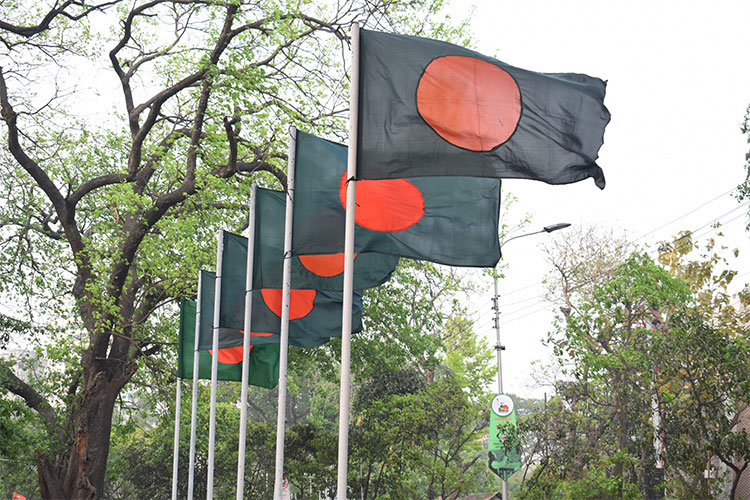Author Recent Posts Rabia Anwaar Latest posts by Rabia Anwaar (see all) US Military Equipment in Afghanistan Fueling Regional Instability – March 27, 2025 Can Trump resolve the Ukraine conflict? – March 11, 2025 Assessment of Pak-Afghan formal and informal channels of Trade – March 11, 2025
In the political history of Bangladesh, students have played a pivotal role in shaping the nation’s destiny. From the Language Movement of 1952 to the War of 1971, the youth of Bangladesh have been at the forefront of every major change. This legacy of activism has not been a mere backdrop to the Bangladesh’s political uncertainty rather it has often been the very force that has driven significant change. As Bangladesh faces yet another period of political turbulence, the role of students in the uprisings against the regime of Prime Minister Sheikh Hasina Wajid has emerged as a critical factor in her eventual downfall.
The influence of student politics on national politics in Bangladesh cannot be overstated. Throughout the Bangladesh’s history, student movements have often acted as an indicator of public sentiment with their actions frequently foretelling broader political shifts. The involvement of student unions in national politics has also meant that these organizations are often the first to react to emerging issues while mobilizing their members to take to the streets and demand action. Student unions and councils in Bangladesh have traditionally been affiliated with major political parties, serving as a breeding ground for future politicians and activists. Organizations such as the Bangladesh Chhatra League (BCL) is linked to the ruling Awami League and the Bangladesh Jatiotabadi Chhatra Dal (JCD) is affiliated with the Bangladesh Nationalist Party (BNP). Such student organizations have employed significant influence over national politics. These student bodies have often acted as the ground-level enforcers of their parent parties’ agendas. For this, they manage to mobilize support during elections, organize protests and sometimes engage in violent confrontations with rival factions.
There also exists symbiotic relationship between student unions and political parties. It means that the actions of the former can have significant repercussions for the latter. For instance, the BCL’s actions are often seen as reflective of the Awami League’s stance on various issues and any mistakes by the student body can lead to backlash against the ruling party. Similarly, opposition student unions like the JCD can act as a catalyst for anti-government movements, leveraging their connections with the youth to organize large-scale protests and amplify calls for change.
Sheikh Hasina’s decade and a half-long rule is acknowledged for Bangladesh’s spectacular economic growth and infrastructural development. However, it has also witnessed increasing authoritarianism. Under her administration, repressive measures of the government against dissent, media censorship, and alleged electoral misconducts gradually alienated significant portions of the population, particularly the youth. It is within this context that the student movement in Bangladesh found its resurgence, becoming a symbol of resistance against the autocracy.
The trigger for student activism under Hasina’s rule can be traced back to several key events, notably the 2018 road safety protests. When two students were killed by a speeding bus in Dhaka, it ignited a nationwide movement demanding safer roads and greater accountability. What began as a call for improved safety measures quickly evolved into a broader critique of government negligence and corruption. The sight of thousands of students, from high school to university, taking to the streets with placards, chanting slogans of reform, highlighted the deep-seated frustrations within the younger generation.
The government of Sheikh Hasina, instead of addressing the grievances, responded with a heavy hand. The deployment of police forces to crush the protests along with reports of violence against students and arrests thus, only fueled the anger. The failure of government to empathize with the students’ demands and its resort to brute force exposed the widening gap between the ruling elite and the youth. Another significant episode was the 2019 student-led protests against the quota system in government jobs which many perceived as unjust and discriminatory. The protesters demanded reforms that would ensure a merit-based system, reflecting the objectives of a generation that felt suppressed by outdated and unfair policies. The government’s response was again marked by repression resulted in consolidating their opposition to Hasina’s rule.
These movements highlighted a fundamental shift in the nature of student politics in Bangladesh. Unlike the earlier decades when student activism was often tied to the agendas of larger political parties, the recent uprisings have been characterized by a more autonomous and organic mobilization. The students were not just protesting specific policies rather they were challenging the very foundation of Hasina’s governance. Their demands for transparency, accountability, and democratic principles resonated with a population increasingly disappointed with the government.
The influence of student unions extends beyond mere political patronage. They have also been pivotal in voicing the concerns of the general student body and the youth of the nation. Issues such as educational reform, unemployment, and political corruption have often been brought to the forefront of national discourse through the activism of student unions. This time, it was the reserved quota in government sector for the martyrs of 1971 war and their descendants. The youth refused to accept the exploitation of their rights in government sector job market. Once again, Sheikh Hasina continued her legacy of crushing the dissents and protests erupted with more than 200 killings of students took place by the brute force of government. The spontaneous nature of student-led protests and their ability to mobilize large numbers of young people make these unions a formidable force in Bangladesh’s political arena.
The fall of Hasina Wajid is influenced by multiple factors and cannot be understood without acknowledging the role of student activism. The persistent pressure from the youth who refused to be silenced despite the government’s oppressive tactics played a crucial historic role in destabilizing her regime. Their ability to galvanize public support, use social media effectively and maintain the momentum of protests highlighted the changing dynamics of political activism in Bangladesh.
It is to say that the student uprisings against Hasina Wajid were not just about opposing a leader; they were about reclaiming the ideals of democracy, justice, and freedom that had been eroded over the years. The fall of her government serves as a manifestation of the power of the youth in challenging authoritarianism and shaping the future of a nation. As Bangladesh moves forward, the legacy of these student movements will continue to inspire future generations and reminding them that they are not just witnesses to history but its makers.
- US Military Equipment in Afghanistan Fueling Regional Instability - March 27, 2025
- Can Trump resolve the Ukraine conflict? - March 11, 2025
- Assessment of Pak-Afghan formal and informal channels of Trade - March 11, 2025













Leave a Comment
Your email address will not be published. Required fields are marked with *